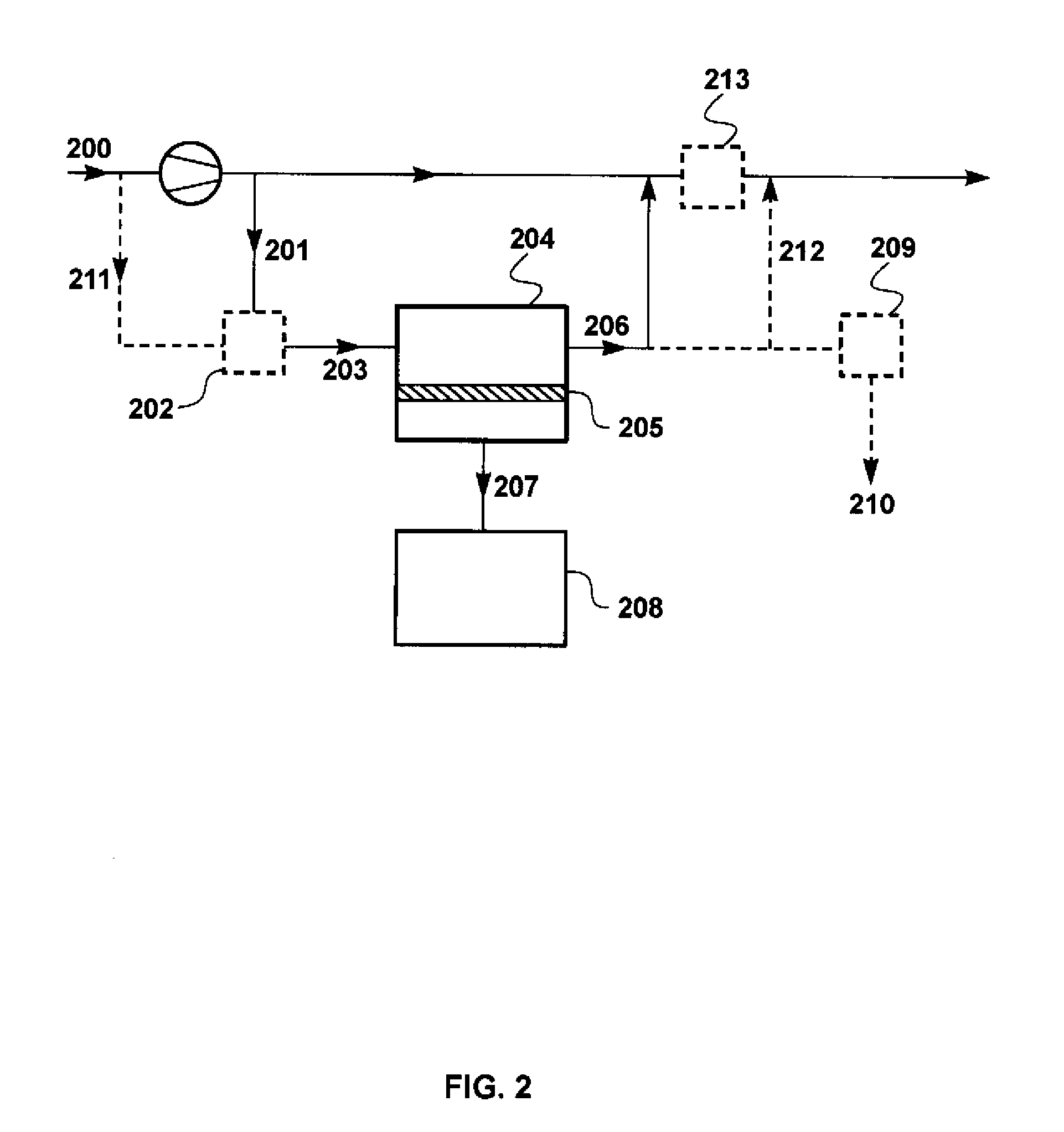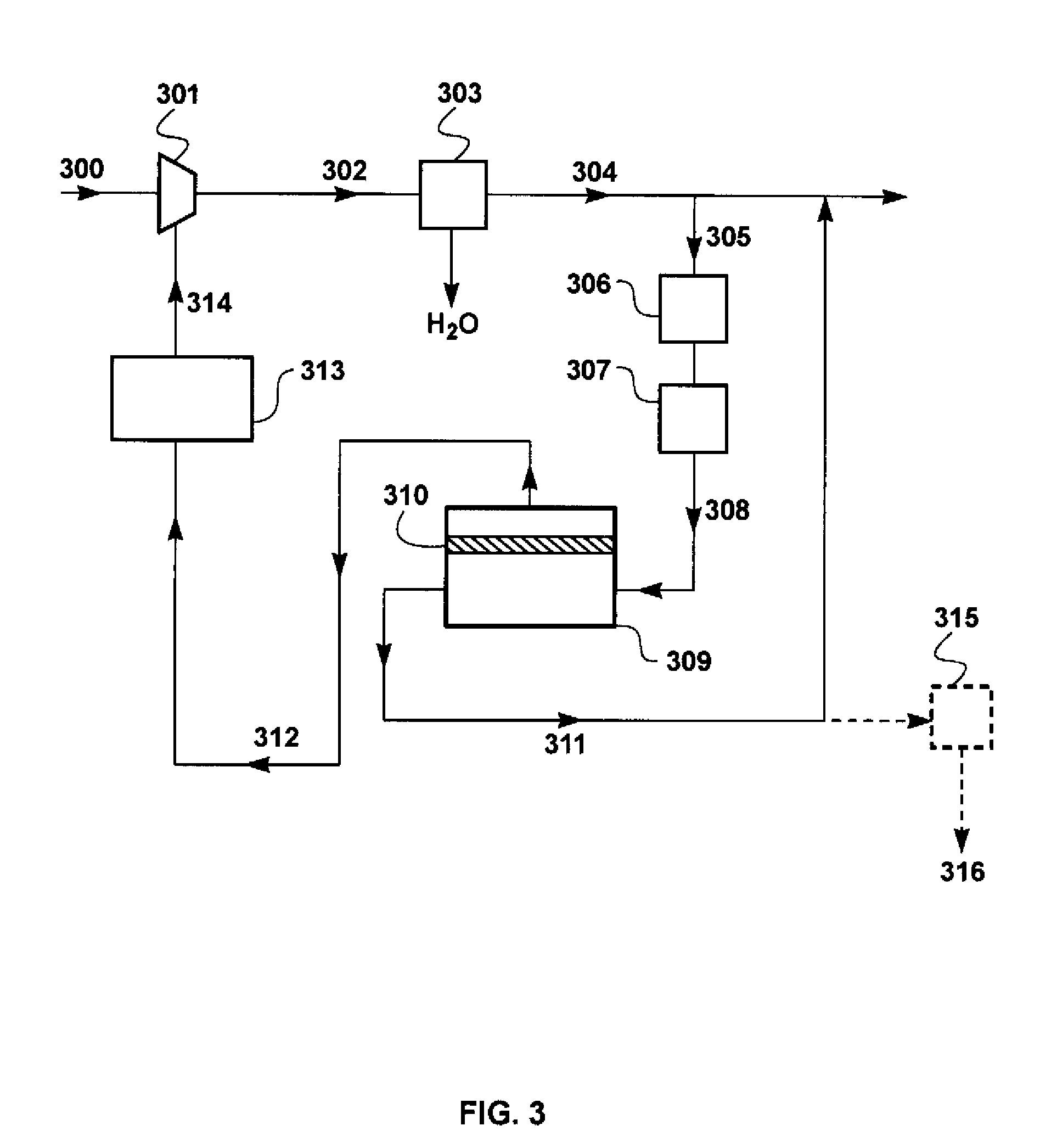Fuel gas conditioning process using glassy polymer membranes
a technology of glassy polymer and gas conditioning process, which is applied in the direction of gaseous fuel, separation process, fuel, etc., can solve the problems of clogging condensation equipment, preventing gas flow, and high btu value of fuel, so as to reduce or avoid, reduce or avoid the effect of recycling through the compressor
- Summary
- Abstract
- Description
- Claims
- Application Information
AI Technical Summary
Benefits of technology
Problems solved by technology
Method used
Image
Examples
examples
[0109]Calculations were performed to compare the composition of conditioned fuel gas produced by membrane separation using traditional rubbery membranes according to the general process shown in FIG. 1 (and disclosed in U.S. Pat. No. 6,053,965) with the composition of conditioned fuel gas produced by membrane separation using glassy perfluorinated polymer membranes according to the process shown in FIG. 3. The calculations were performed using a modeling program. ChemCad 5.6 (ChemStations, Inc., Houston, Tex.), containing code for the membrane operation developed by MTR's engineering group. Gas feed pressure is assumed to be 325 psia for both the traditional rubbery and glassy perfluorinated membranes; permeate pressure was assumed to be 150 psia and 115 psia for the rubbery and glassy membranes, respectively. Operating temperature was assumed to be room temperature. The same membrane area (200 m2) was assumed to be used for both membrane types.
[0110]The results of this comparison a...
examples 2-5
[0113]A set of calculations was performed to show the effect of membrane stage cut (the percentage of the feed gas permeating the membrane). The calculations were modeled on the process scheme of FIG. 2 in conditioning a fuel gas produced by membrane separation using glassy perfluorinated polymer membranes. The calculations were performed using a modeling program, ChemCad 5.6 (ChemStations, Inc., Houston, Tex.), containing code for the membrane operation developed by MTR's engineering group.
example 2
[0114]The calculations were performed assuming a 55% stage cut, The feed stream was assumed to be at a pressure of 660 psia and a temperature of 50° C., and the permeate side of the membranes was assumed to be maintained at 160 psia. The results of the calculations are shown in Table 3. The stream numbers correspond to FIG. 2.
TABLE 3ResidueFeed GasStreamConditioned Fuel GasStream(203)(206)(207)Total kg / h8,0903,6044,486Component (vol %)Methane88.487.789.0Ethane8.110.56.1Propane0.30.60.2Carbon2.00.63.1DioxideNitrogen1.10.61.6
[0115]In this case, operation at a relatively high stage cut increased the methane content of the fuel gas to 89 vol % and reduced the C2+ hydrocarbon total content from 8.4 vol % to 6.3 vol %.
PUM
| Property | Measurement | Unit |
|---|---|---|
| vol % | aaaaa | aaaaa |
| vol % | aaaaa | aaaaa |
| temperature | aaaaa | aaaaa |
Abstract
Description
Claims
Application Information
 Login to View More
Login to View More - R&D
- Intellectual Property
- Life Sciences
- Materials
- Tech Scout
- Unparalleled Data Quality
- Higher Quality Content
- 60% Fewer Hallucinations
Browse by: Latest US Patents, China's latest patents, Technical Efficacy Thesaurus, Application Domain, Technology Topic, Popular Technical Reports.
© 2025 PatSnap. All rights reserved.Legal|Privacy policy|Modern Slavery Act Transparency Statement|Sitemap|About US| Contact US: help@patsnap.com



